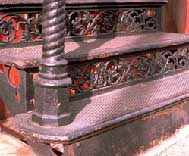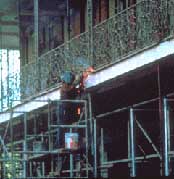
  

























 |

Well-maintained historic metal storefront. |
Architectural
metal features--such as cast iron facades, porches, and steps; sheet
metal cornices, siding, roofs, roof cresting and storefronts; and
cast or rolled metal doors, window sash, entablatures, and hardware--are
often highly decorative and may be important in defining the overall
historic character of the building.
Metals
commonly used in historic buildings include lead, tin, zinc, copper,
bronze, brass, iron, steel, and to a lesser extent, nickel alloys,
stainless steel and aluminum. Historic metal building components
were often created by highly skilled, local artisans, and by the
late 19th century, many of these components were prefabricated and
readily available from catalogs in standardized sizes and designs.
|
|
Architectural
Metals
|
....Identify,
retain, and preserve
|
 |
|
recommended.....
|

|
| |

Cast-iron steps with distinctive cut-out work. |
Identifying,
retaining, and preserving architectural metal features such as columns,
capitals, window hoods, or stairways that are important in defining
the overall historic character of the building; and their finishes
and colors. Identification is also critical to differentiate between
metals prior to work. Each metal has unique properties and thus
requires different treatments.
|
|
not
recommended.....
|

|
| |
Removing
or radically changing architectural metal features which are important
in defining the overall historic character of the building so that,
as a result, the character is diminished.
Removing
a major portion of the historic architectural metal from a facade
instead of repairing or replacing only the deteriorated metal, then
reconstructing the facade with new material in order to create a
uniform, or "improved" appearance.
Radically
changing the type of finish or its historic color or accent scheme.
|
|
Architectural
Metals
|
....Protect
and Maintain
|
 |
|
recommended.....
|

|
| |
Protecting
and maintaining architectural metals from corrosion by providing proper
drainage so that water does not stand on flat, horizontal surfaces
or accumulate in curved, decorative features.
Cleaning
architectural metals, when appropriate, to remove corrosion prior
to repainting or applying other appropriate protective coatings.
Identifying
the particular type of metal prior to any cleaning procedure and
then testing to assure that the gentlest cleaning method possible
is selected or determining that cleaning is inappropriate for the
particular metal.

Applying a protective coating to bronze doors after cleaning. |
Cleaning
soft metals such as lead, tin, copper, terneplate, and zinc with
appropriate chemical methods because their finishes can be easily
abraded by blasting methods.
Using
the gentlest cleaning methods for cast iron, wrought iron, and steel--hard
metals--in order to remove paint buildup and corrosion. If handscraping
and wire brushing have proven ineffective, low pressure grit blasting
may be used as long as it does not abrade or damage the surface.
Applying
appropriate paint or other coating systems after cleaning in order
to decrease the corrosion rate of metals or alloys.
Repainting
with colors that are appropriate to the historic building or district. Applying an appropriate protective coating, such as lacquer to an architectural metal feature, such as a bronze door which is subject to heavy pedestrian use.
Evaluating
the overall condition of the architectural metals to determine whether
more than protection and maintenance are required, that is, if repairs
to features will be necessary.
|
|
not
recommended.....
|

|
| |
Failing
to identify, evaluate, and treat the causes of corrosion, such as
moisture from leaking roofs or gutters.

Clogged gutter leading to corrosion. |
Placing
incompatible metals together without providing a reliable separation
material. Such incompatibility can result in galvanic corrosion
of the less noble metal, e.g., copper will corrode cast iron, steel,
tin, and aluminum.
Exposing
metals which were intended to be protected from the environment.
Applying
paint or other coatings to metals such as copper, bronze, or stainless
steel that were meant to be exposed.
Using
cleaning methods which alter or damage the historic color, texture,
and finish of the metal; or cleaning when it is inappropriate for
the metal.
Removing
the patina of historic metal. The patina may be a protective coating
on some metals, such as bronze or copper, as well as a significant
historic finish.
Cleaning
soft metals such as lead, tin, copper, terneplate, and zinc with
grit blasting which will abrade the surface of the metal.
Failing
to employ gentler methods prior to abrasively cleaning cast iron,
wrought iron or steel; or using high pressure grit blasting.
Failing
to re-apply protective coating systems to metals or alloys that
require them after cleaning so that accelerated corrosion occurs.
Using
new colors that are inappropriate to the historic building or district.
Failing
to assess pedestrian use or new access patterns so that architectural
metal features are subject to damage by use or inappropriate maintenance
such as salting adjacent sidewalks.
Failing
to undertake adequate measures to assure the protection of architectural
metal features.
|
|
Architectural
Metals
|
....Repair
|
 |
|
recommended.....
|

|
| |
Repairing architectural
metal features by patching, splicing, or otherwise reinforcing the
metal following recognized preservation methods.

Repairing a decorative iron balcony. |
Repairs may also
include the limited replacement in kind--or with a compatible substitute
material--of those extensively deteriorated or missing parts of
features when there are surviving prototypes such as porch balusters,
column capitals or bases; or porch cresting.
|
|
not
recommended.....
|

|
| |
Replacing
an entire architectural metal feature such as a column or a balustrade
when repair of the metal and limited replacement of deteriorated
or missing parts are appropriate.
Using
a substitute material for the replacement part that does not convey
the visual appearance of the surviving parts of the architectural
metal feature or that is physically or chemically incompatible.
|
|
Architectural
Metals
|
....Replace
|
 |
|
recommended.....
|

|
| |

Missing cast-iron elements replaced with cast aluminum. |
Replacing
in kind an entire architectural metal feature that is too deteriorated
to repair--if the overall form and detailing are still evident--using
the physical evidence as a model to reproduce the feature. Examples
could include cast iron porch steps or steel sash windows. If using
the same kind of material is not technically or economically feasible,
then a compatible substitute material may be considered.
|
|
not
recommended.....
|

|
| |
Removing
an architectural metal feature that is unrepairable and not replacing
it; or replacing it with a new architectural metal feature that
does not convey the same visual appearance.
|
| |
Design
for Missing Historic Features
The
following work is highlighted to indicate that it represents the
particularly complex technical or design aspects of rehabilitation
projects and should only be considered after the preservation concerns
listed above have been addressed.
|
|
recommended.....
|

|
| |
Designing
and installing a new architectural metal feature such as a metal
cornice or cast iron capital when the historic feature is completely
missing. It may be an accurate restoration using historical, pictorial,
and physical documentation; or be a new design that is compatible
with the size, scale, material, and color of the historic building.
|
|
not
recommended.....
|

|
| |
Creating
a false historical appearance because the replaced architectural
metal feature is based on insufficient historical, pictorial, and
physical documentation.
Introducing
a new architectural metal feature that is incompatible in size,
scale, material and color.
|
|

